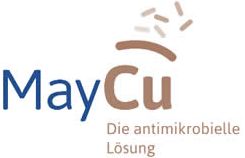

World innovation
The antimicrobial door fittings
- Compared to conventional contact surfaces the May CU® doorknobs and fittings show a reduction of up to 99.9 % of bacteria within a very short time.
- They are cast in a special copper alloy and retain their antimicrobial effect over decades.
- Their material properties are also retained even if they are treated with cleaning and disinfection agents.
- The May CU® product portfolio shows a range door handles, door plates and doorknobs for external and internal use.
- Clearly recognisable through a striking logo and the accompanying brand name May CU®.
Copper is effective. Permanent. Antimicrobial.
Simply the thought of what bacteria the previous user of the door handle could have left there makes you want to avoid using touching the handle. But frequently this is simply unavoidable. Consequently, for instance walking through a hospital becomes a precarious health risk for patients and visitors, because touching door handles in institutions where there are a great number of visitors often does not remain without consequences. The transfer of pathogens is almost unavoidable, since germs can survive several days on conventional materials. Investigations have shown that on average a sick person transfers the pathogens to seven persons simply through them touching the same contact surface. This risk of infection particularly has far-reaching consequences in clinics or old people's homes, since the reduced immune defence of elderly people, patients and also children's immune systems � which are not yet sufficiently developed � accordingly intensify the risk of infection.
The May CU® oor and window fittings are made out of a special copper alloy. Here we rely on a property of copper which was already known 4000 years ago. The ancient Egyptians used the disinfecting effect of copper by treating wounds with a mixture of copper filings and honey.
 In the USA laboratory investigations have supported the thesis that the antimicrobial effect of copper will play an important role in the future for avoiding hospital infections. All strains of bacteria used for the tests showed a significantly reduced chance of survival on copper. The strains of bacteria also included MRSA bacteria. These pathogens are very frequently responsible for infections caught in hospitals. MRSA bacteria are increasingly attracting the attention of scientists, because these germs are presenting research throughout the world with a growing challenge because of their increasing resistance to antibiotics.
In the USA laboratory investigations have supported the thesis that the antimicrobial effect of copper will play an important role in the future for avoiding hospital infections. All strains of bacteria used for the tests showed a significantly reduced chance of survival on copper. The strains of bacteria also included MRSA bacteria. These pathogens are very frequently responsible for infections caught in hospitals. MRSA bacteria are increasingly attracting the attention of scientists, because these germs are presenting research throughout the world with a growing challenge because of their increasing resistance to antibiotics.
In an interview with the German newspaper Hamburger Abendblatt, Prof. Dr. Braun (head doctor of the Asklepios clinic in Wandsbeck) explained why his clinic had been willing to take part in a field test. "The fight against this highly-resistant pathogen cannot be won with conventional measures, such as always using new antibiotics and intensive disinfection measures. We have to adapt new approaches to reduce the risk potential for our patients*
In this globally recognised and scientifically supported series of tests a complete hospital ward was fitted with copper door handles and door fittings from the company Wilhelm May.
The results of the study showed that the antimicrobial effect of copper had an important role to play in fighting bacteria and viruses. The copper fittings continually reduce the number of germs. Up to 99.9 % of germs, including the dangerous MRSA pathogen, are killed within a short time on copper surfaces.** Hence, for instance in the Asklepios clinic it could also be proved under everyday conditions that the rate of new colonisation by germs was considerably reduced. The positive result of this was that there were fewer infections at the ward which was equipped with May CU® fittings.
Sources
* Hamburger Abendblatt, 21.08.2008, Page 18, Rubrik Wissen
** JOURNALMED.de, 2008-08-26 (Source: Informationsdienst Wissenschaft)
*** Asklepioskliniken Hamburg GmbH, Konzernbereich Unternehmenskommunikation und Marketing, presse@asklepios.com
**** Deutsches Kupferinstitut, ikeller@kupferinstitut.de

